First descents of the 3 major sections in 2007, by Alain Rohr et al:
- Bruno Fromento, Bruno’s companion (name unknown), Alain
- Annette Philipps, Tristrain, Alain
- Tristrain, Alain
Access on the TR, about 3hrs.
Descent, 8-10hrs
This is such a long canyon, that information from those who have visited it is general to say the least. One thing is true, it is an extremely long canyon, requiring good fitness, efficiency, teamwork and skill.
There is didymo in the Makarora: take alternative footware and/or cleaning solution to ensure you don’t bring it into the canyon!
Very few bolts present: lots of human anchors, natural anchors, sketchy downclimbs and jumps required to move quickly through this very long canyon.
This is canyon which could really do with some work bolting it up nicely to be a Haast mega-classic…
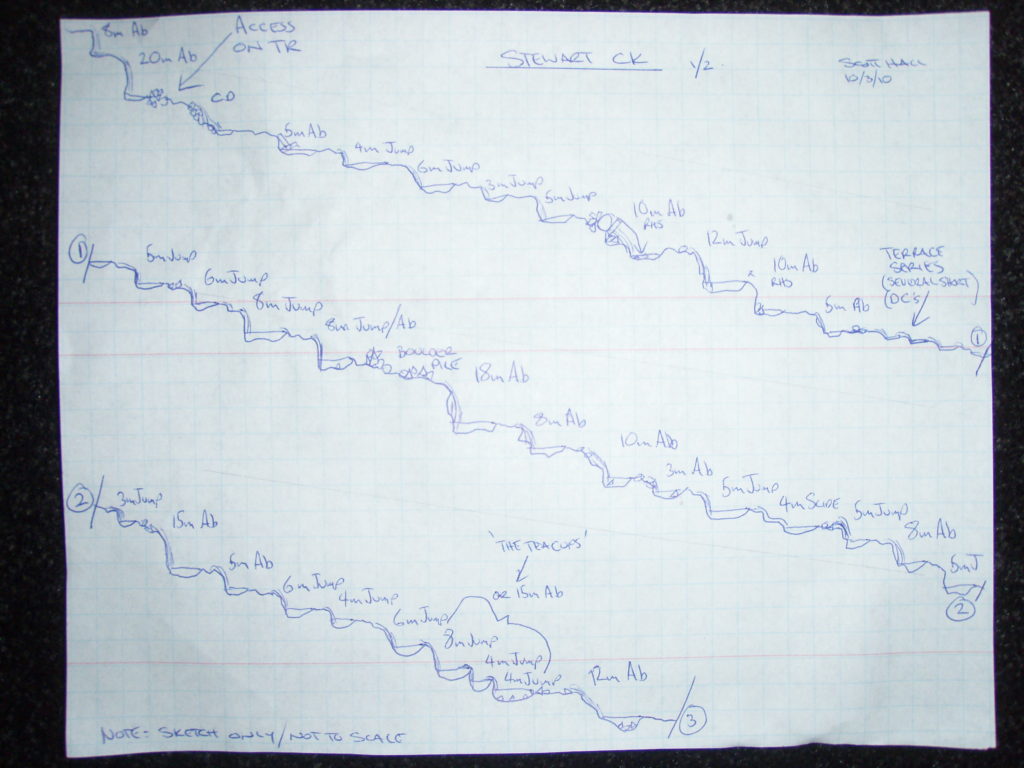
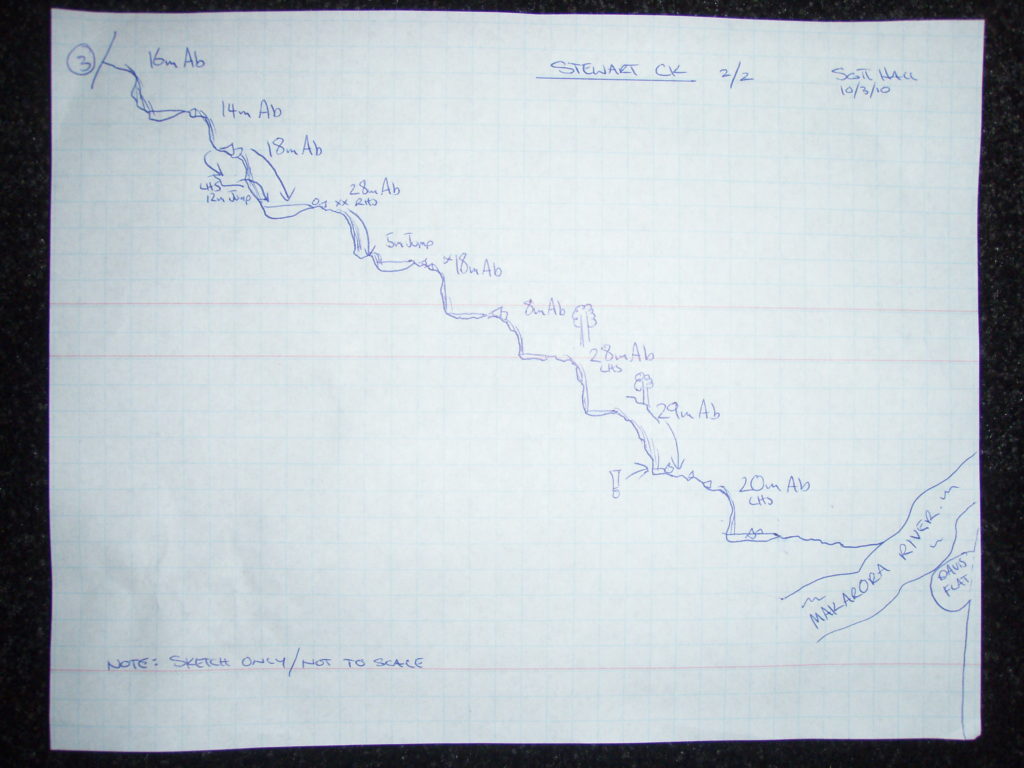
After climbing for a few hours, we found ourselves within 150m of the tree line and looking Into the top of the canyon. The section we could see upstream looked to be rather wide and open with no visible drops so we decided to follow a small ridge down Into the canyon directly below the first visable waterfall which was approx 100-150m from the tree line.
.
After getting suited up and having a late morning snack we started off down the
canyon. The first section went by rather fast but we seemed to be moving quickly
having done approx 12 jumps (most around 6 – 12m) into beautiful deep pools and 7 or 8 abseils. The upper section of the canyon was very continuous with no more than 50m between each pool. Most of the drops had lots of water and the amount of jumps was hard to believe..
As we continued down the canyon it was like a canyoning marathon with pool after pool and drop after drop. As we travelled through the middle section of the canyon we were surprised at each drop with even more jumps and amazing sections of deep carved canyon. The middle section Involved more rope work and multiple sections where we found ourselves down climbing slightly smaller waterfalls to keep moving but a hand line was useful.
.
Near the start of the bottom section we spent more and more time on rope but
still had plenty of jumps. The most spectacular thing we found was a short series of hanging pools that we nicknamed the teacups. This was 3 hanging pools one after the other that was a series of jumps. 8m,5m and 4m one after the other (Can be abseiled also) that was simply amazing! The lower section of the canyon mostly envolved abseils upto 30m and was not quite so deep but just as
Impressive. As we neared the the final drops both of us were getting very tired
and each time the rope was coiled we were hoping It may be the last..
Sure enough after approx 50 drops (approx 25 jumps and 25 abseils) and many climb down sections we reached the Makarora river.
Scott Hall, from a descent on 10 March 2010
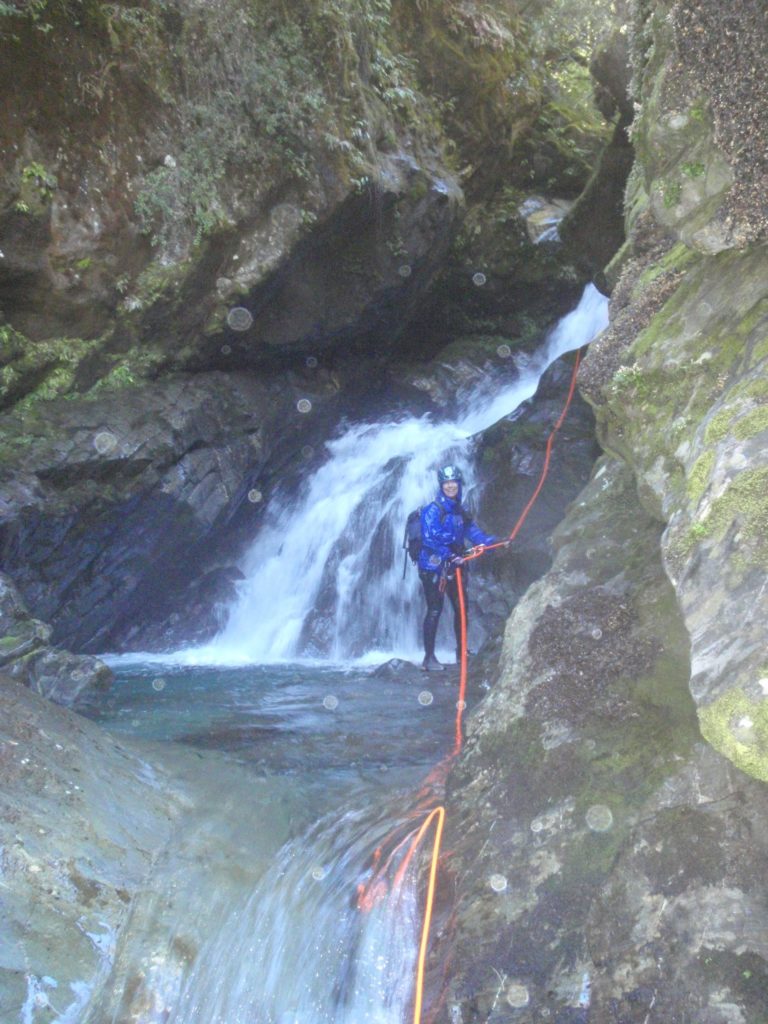
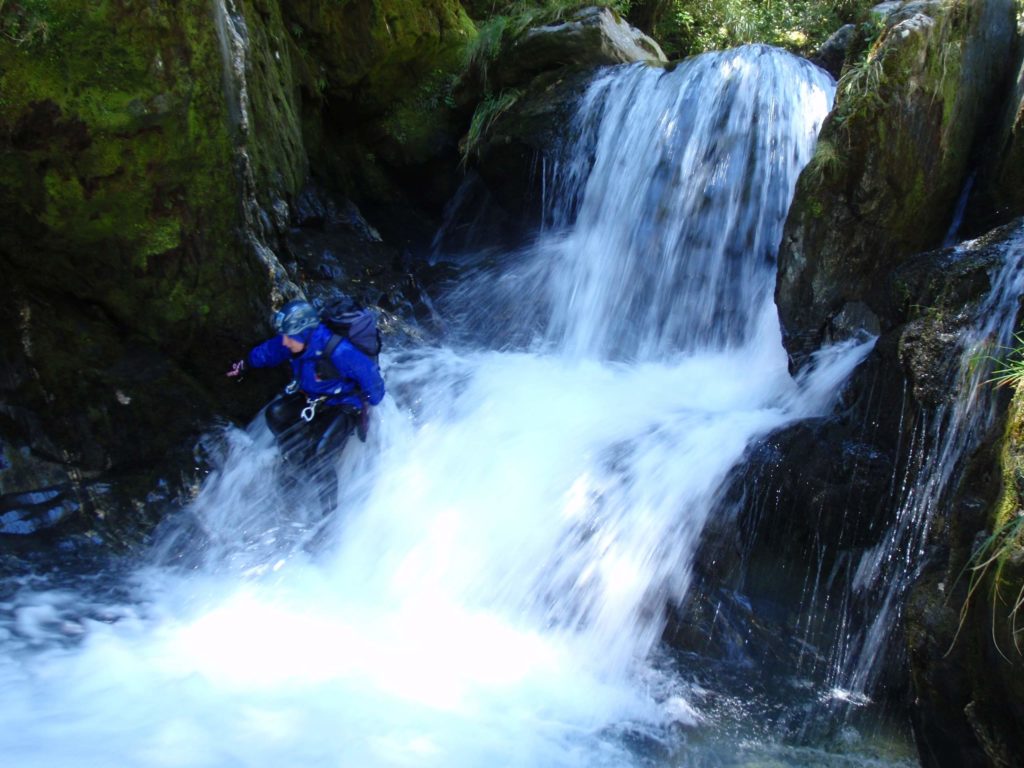
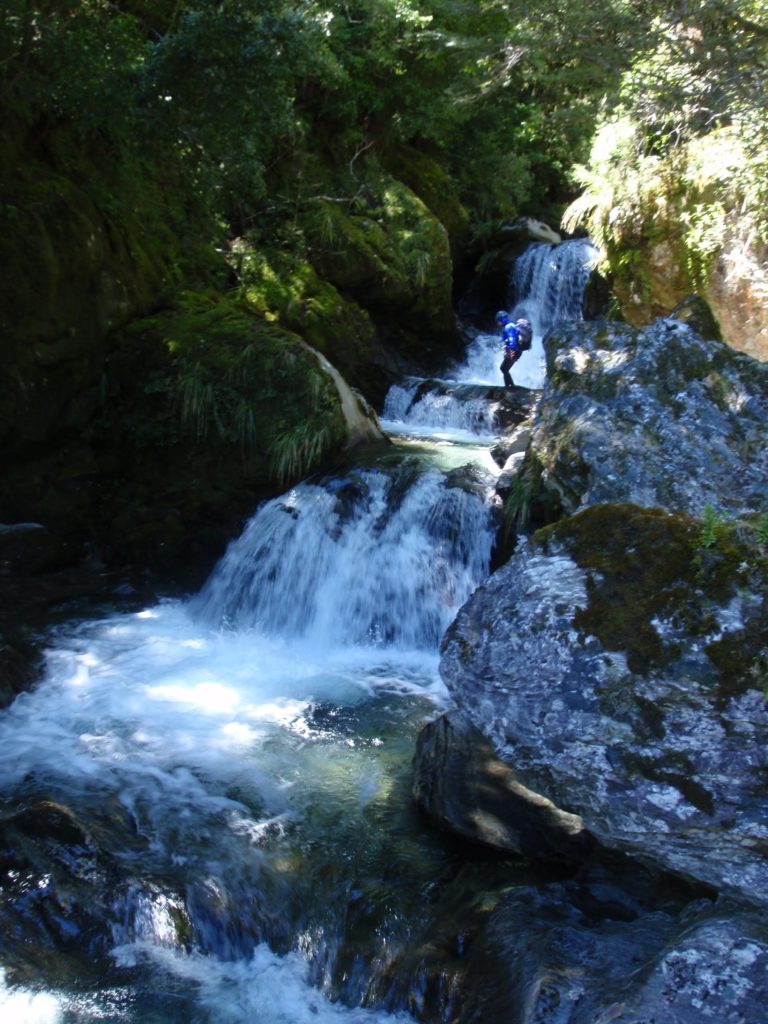

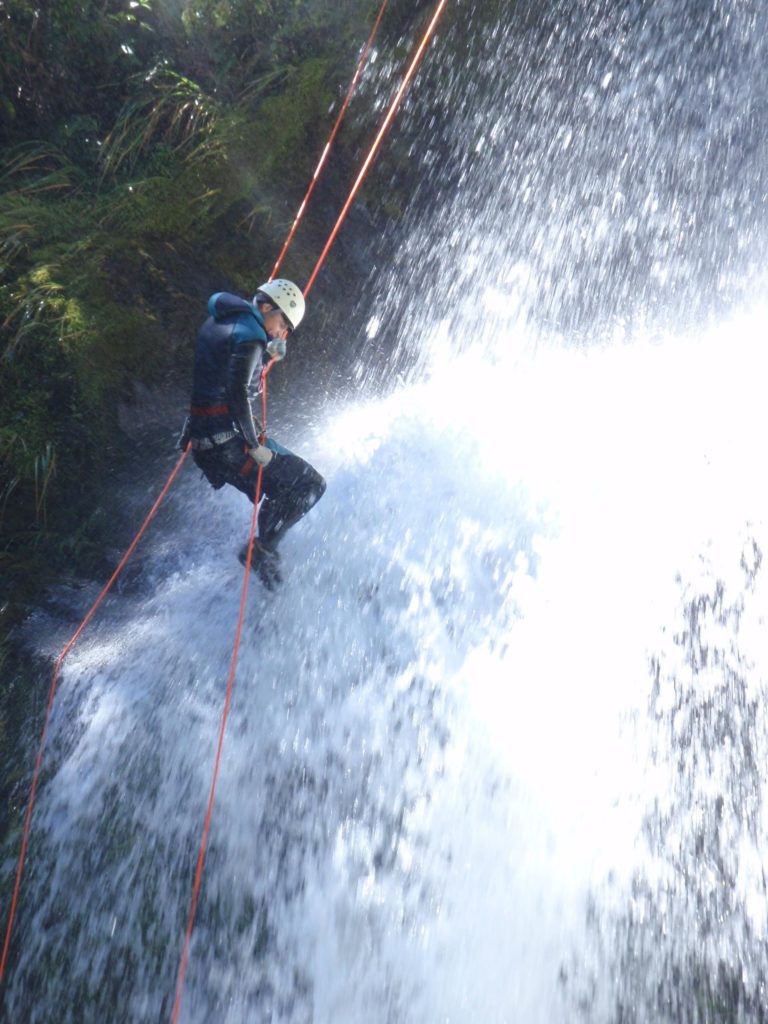








Bolted a fair few pitches, used a few trees in the lower section.
Otherwise, completely covered in didymo, the slimiest slipperiest canyon.
Information on Descend of Stewarts Creek on the 12.2.2016 done by Conner, Kelton and Max.
Approach (took us around 2h45min):
We parked shortly before the highway bridge which is situated before Davis Flat, then walked to the bridge and took the track to the end of the canyon, crossed it (water level seemed low) and moved up on the track on the TR. At around 550m altitude we left the track and followed up to 1050m trough “quite” open bush. Then we continued at 1050m for a few hundred meters before a descend into the canyon seemed possible. When we hit the canyon we still could see smaller drops above us, maybe we should have gone a little further on 1050m, but we definitely found the first good spot to enter the canyon because when we looked further down on the TR of our entry point were big walls. We reached the water in the canyon at 1010m. The reason we approached on the track from before the bridge was to avoid crossing the Makarora and needing to clean our gear of didymo before entering Stewarts. However, it appeared that there was didymo (or at least dirt and seaweed) in Stewarts already, especially in the walkout in the end (this should be confirmed by someone from NZ). If there was already didymo it would be best to approach directly from Davis Flat which is just across the river from Stewarts Creek.
Descend (took us around 8h incl. lunch break):
In the beginning we could not find any bolts or slings in the canyon. We did some down climbs and meat anchors plus spotting for the last person. After a while we could find a first single bolt with an quite tricky approach. Further in the canyon some bolts were found but mostly we had to use improvised natural anchors and loads of sometimes quite tricky jumps. From the vegetation on the side it was possible to see that the canyon gets a lot of water. We were lucky being in the canyon after a two week dry period, otherwise some of the down climbs, approach climbs and guessed jumps would have not been possible. The canyon itself was long but definitely entertaining, no really long walking or boldering between the rappels and loads of different jumps. We brought more ropes then the description was indication (2x40m, 1x60m) but we were really happy using these, I would definitely would recommend bringing 2x40m to deal with current anchors.
Anchor situation:
Except for the last section of the canyon with a few 25-30m waterfalls in a row the anchor situation was quite bad. We could find double bolt anchors only two times before the waterfalls in the end but there were around 18 rapells before. Sometimes you could see holes of old bolts but they have been placed to close to the flow and so easily got washed away. Also some bolts clearly seemed to be emergency bolts, the 8mm self-drilling expansion bolts for example. Most of the anchors we used were relying on access to the sides of the canyon or using some bolders or logs but a canyon keeps changing, who knows if the natural anchor we used last time will be there when you go so gear to make anchors is a must have. To give you an idea, if I go in the canyon again I would bring a drilling machine and at least 20 bolts and some rope slings with me.
Personal Comments:
The approach was easy, if you think of a combined approach of ZigZag and Wilson this is what you get (time- and bush-wise). In the canyon the major issues were down climbing, followed by finding or building anchors followed by technical jumps and fitness. The length of the canyon is huge, to give an idea think of descending 1xZigZag and 2xWilson at least. The ration between approach and descend is really good here, if the anchor situation gets better this is a really awesome day in the canyon and I would love to see it in the next edition of the book.